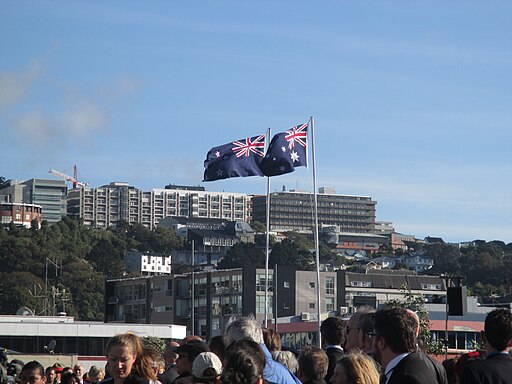 |
| New Zealand and Australian flags by Wiremu Stadtwald Demchick (CC BY 4.0). |
Last year I wrote a chapter on political leadership with Stewart Jackson from the University of Sydney. I now use it in my class on Political Leadership at the University of Canberra.
I aim to teach students about leadership while incorporating political leaders as case study material. The approach provides an opportunity to bring in aspects of the liberal arts and liberal democratic tradition that seem to have taken a back seat in recent years.
At the same time, I aim to teach students how to think, not what to think, and I encourage students to test and challenge not only their own views but the views that are often driven by the news media.
I encourage students to read widely about our political leaders and take advantage of the numerous webinars that are now commonplace. This gives students a perspective that is often quite different from the news media of all persuasions.
I have found that the news media portrays our political leaders as caricatures (exaggerating characteristics for grotesque effect) and often as morons. This does little to instil public confidence in our political leaders or in our political system. Given recent geopolitical events, I find the portrayal of politicians by the media tends to make politics a spectator sport rather than The Great Conversation we all participate in whether actively or not.
There are two particular cases that bother me on multiple levels. First, Jacinda Ardern is portrayed as the caring female as per the stereotype yet she has been able to keep NZ Labour and a disparate coalition together through an apparently authoritarian streak we don’t get to see (noting this is from a left-leaning paper which usually supports Ardern).
Second, Scott Morrison is portrayed as a goofy dad (probably not helped by his recent memes) but at the same time, Barnaby Joyce was afraid of him (who can imagine Barnaby Joyce being afraid of anything?) and Paul Kelly’s Lowy Institute paper Morrison’s Mission where Kelly outlines how Morrison’s legacy is AUKUS and he has set the future direction for our defence strategy for the next generation.
I am not trying to sway students one way or another, but hopefully, the examples above encourage students to cast a critical eye over the perception the news media generates about our political leaders.
The sociocognitive element in leadership is probably the best concept to help us understand this phenomenon of media portrayal.
In effect, the news media presents political leaders as 'celebrities' - either for one idealised aspect of leadership or another - while ignoring the complex array of systems and people that support the leader in their role.
The sociocognitive aspect explains why there is often a distinction between the public persona versus the leader within their party and the parliament more generally (think Kevin Rudd and his swearing about his staff or verbally abusing a RAAF flight attendant).
I asked conservative culture warrior Kevin Donnely about the outward-looking versus inward-looking nature of political leadership at his book launch at The Sydney Institute last year. Donnelly emphasised the importance of political leaders 'speaking' to their 'base'.
Now turn to Ardern, who will again be seen as doing the right thing during the flood crisis and talking about climate change resilience. This will go down well in the left-wing media. But can any political leader be as empathetic within the corridors of power as they can be in the public sphere?
The truth is, nobody survives politics if they are soft – and I daresay Ardern is very different from her public persona in the party room.
My point is that even if one decides that Ardern is great and Morrison or Andrews are not great, one should try to look at both sides of the picture. And be aware of the ideological positions adopted by the various news media outlets.
I watched the Bolt Report last night, for example, and he and Michael Kroger were paying out on former Labor Communications Minister Stephen Conroy, but Conroy didn’t seem to care – perhaps he is being paid by Sky to be the conservative’s punching bag(?).
But to read The Guardian or The Conversation we can see that these outlets routinely take up the opposite position. My point is to cast a critical eye over the news media's portrayal of our political leaders, and beware the influence of stereotypes.
What do I mean by stereotypes? Think of the policy achievements of Julia Gillard as Australia's first and (so far) only female prime minister. Despite being referred to as:
highly engaging in close quarters and confident in the Parliament, but this did not translate effectively through the electronic media.
Despite negotiating a hung parliament, implementing the National Disability Insurance Scheme and the royal commission into child sexual abuse, Gillard is largely remembered for her misogyny speech.
In 2019, Gillard said she was 'left feeling a little resentful', and:
There was a time where I was a little resentful that all those years in politics, and all of that work, and everything we did… that all of it apparently came down to one moment in time, one speech.
Where does this leave us? If we look at the responses to Gillard's misogyny speech in the days immediately following, the media were not so quick to get on board. Even Michelle Grattan wrote that Gillard was 'desperate'. Later, the public got on board. And so here we are back at the sociocognitive element of political leadership.
As I always say to my students, scratch the surface, peel back the layers, challenge the trends, and make up your own mind.
 Donate
Donate






No comments
Post a Comment